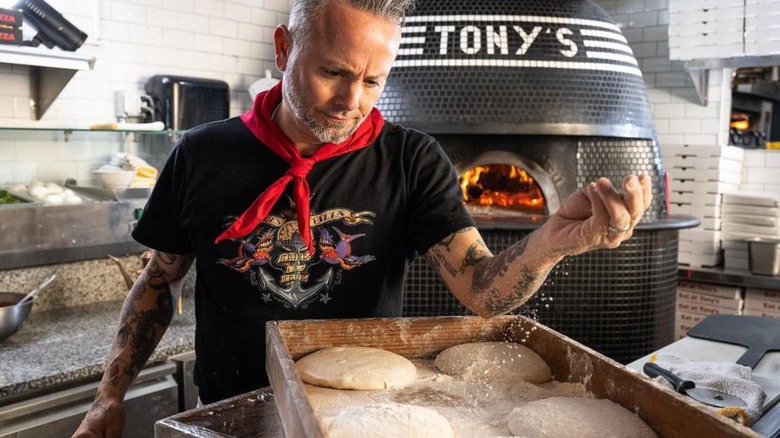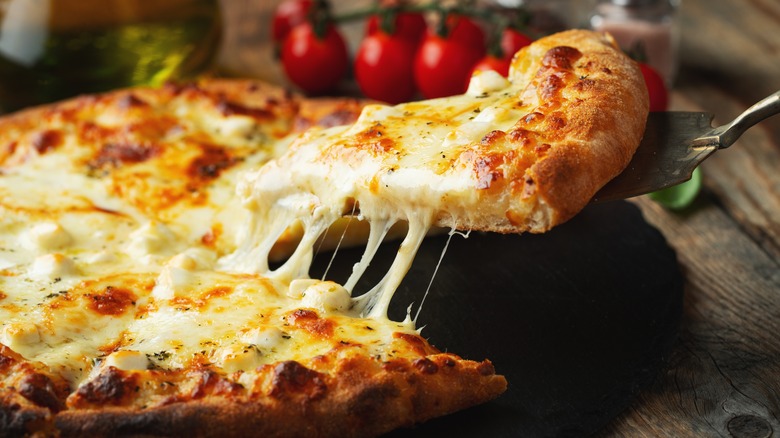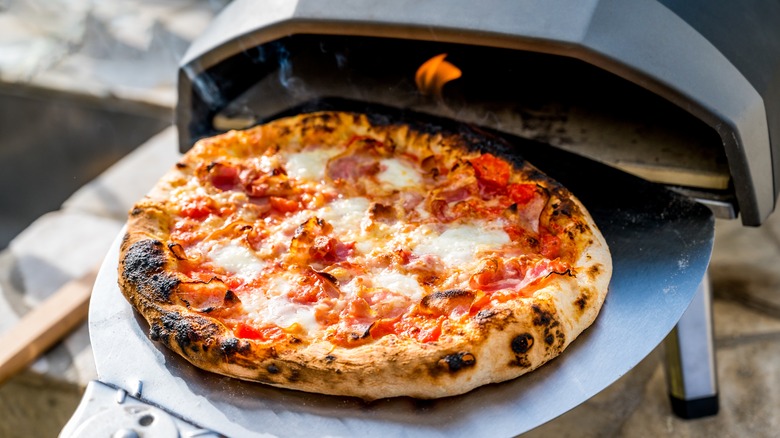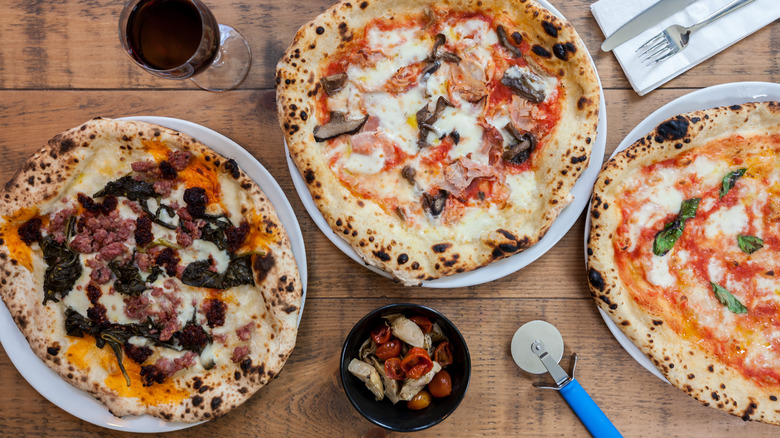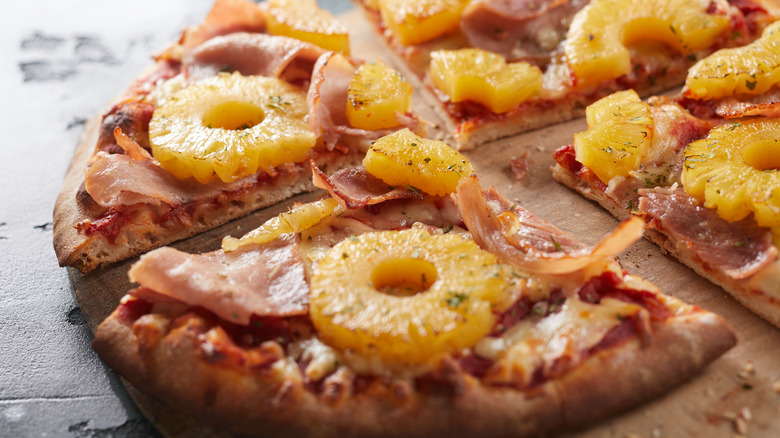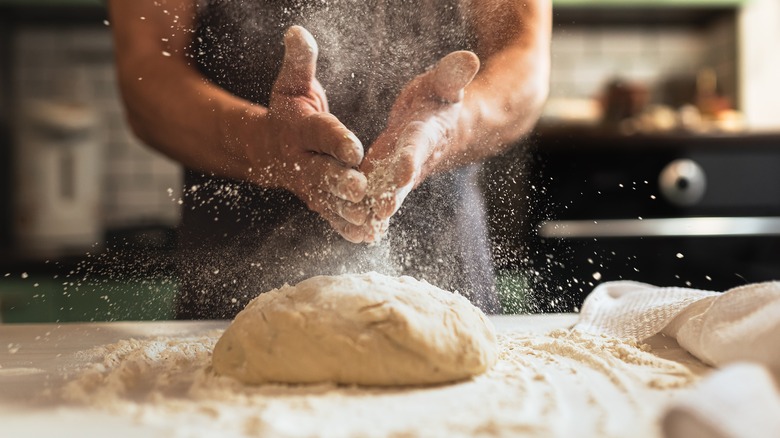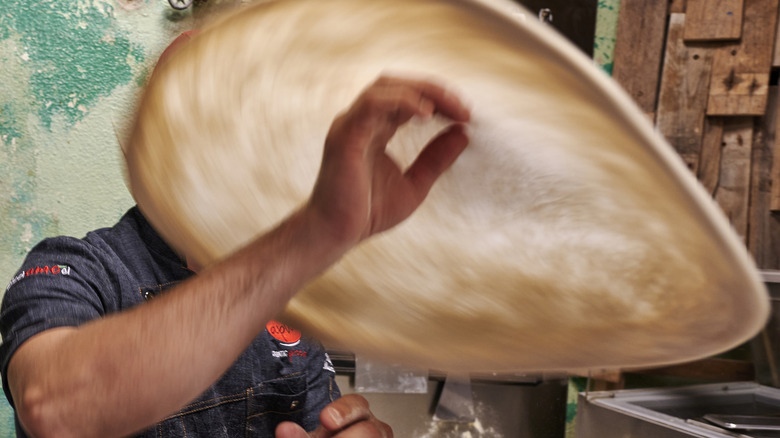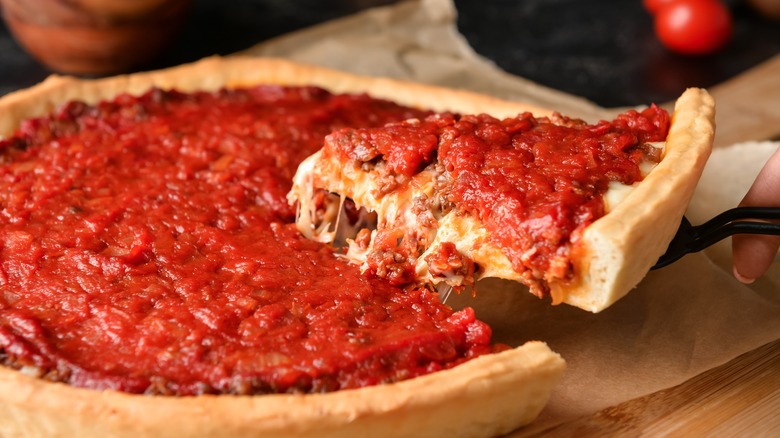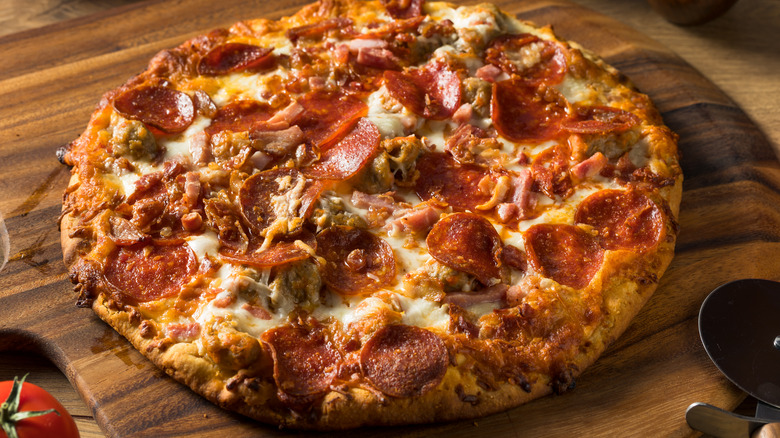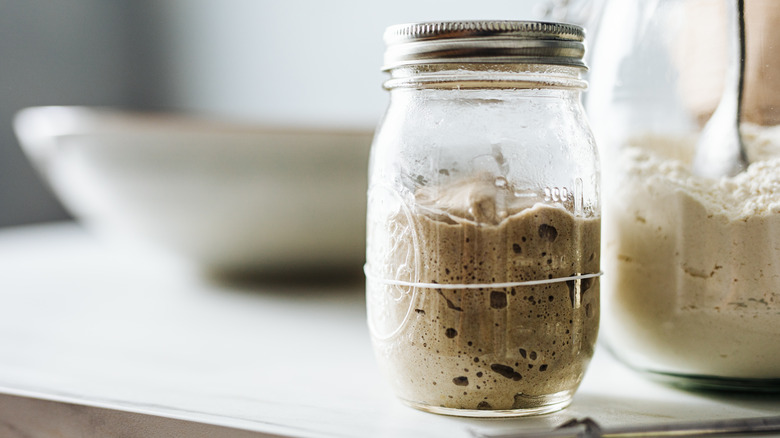9 Pizza Myths You Can Stop Believing, According To World Champion Pizzaiolo Tony Gemignani
We may receive a commission on purchases made from links.
Calling all pizza fans, this one is for you! Whether you have your favorite pizza shop on speed dial, the app committed to muscle memory, or you prefer to fire up the Ooni pizza oven and make your own, there are a number of myths that might just be standing in between you and the best pie you've ever eaten.
Misconceptions about any foods are normal, especially ones like pizza that have traveled the world, changing and adapting as they go. Lucky for pizza lovers everywhere, the world pizza cup champion pizzaiolo (the term used for pizza chefs) restaurant owner, and author of his latest book, "The Pursuit of Pizza" Tony Gemignani, is here to dispel some of these myths holding you back from experimentation, enjoyment, and ultimately a delicious pizza.
Pizza enthusiasts from all over the globe will soon be congregating in Los Angeles to take part in Pizza City Fest, taking place April 27th and 28th. There, you'll have a chance to catch Gemignani and his pizza- and dough-related advice in person. And while seeing this high-flying pizza thrower in person is ideal, Gemignani's advice remains evergreen. Gather your favorite ingredients and pizza toppings, fire up those ovens, and read on to hear why some of these pizza myths are ready to be retired for good.
Homemade pizza isn't worth the effort
We get it. It's Friday night after a long and busy week. All you want to do is stretch out on the couch with your favorite pizza and binge-watch whatever series Netflix is currently showing. "Homemade pizza just isn't worth the effort," you think. Tony Gemignani wants you to think again.
"It is absolutely worth the effort," says Gemignani, "If you have the right recipe, a clear explanation of the various steps, and the right ingredients (flour being the most important!), it can turn out beautifully and taste delicious."
No one is saying to get off that couch or deny the local pizzeria your unwavering support. Why not have both? Consider bookmarking a weekend afternoon as the perfect time to experiment with your own pizza-making skills. After a few practice rounds, you'll be ready to invite your friends over to sample your efforts.
Pizza making is an art, and it beckons you to discover more about what you like and don't like, what ingredients are worth investing in, what skills you didn't even know you had, and how to make pizza even more delicious than you had previously thought possible. As Gemignani reminds us of making pizza at home, "It's a labor of love that is well worth it for the final product."
It's not worth investing in a pizza steel
If you're wondering how your favorite local pizza joint gets its crust so crispy and its cheese so melty, the secret might be under, rather than inside, the pizza itself. We're talking about pizza steels. "Pizza steels are definitely worth investing in if you are making pizza at home," says Tony Gemignani, "and I would say it's even better to invest in two."
The purpose of using a pizza stone, which is typically made from clay, cordierite, or ceramic materials, is to help create that crispy-meets-tender dough using a ripping hot bottom. Similar to a pizza stone, with pizza steels, it's all in the name; the cooking material is industrial-grade steel. The reason to consider steel is that each material conducts heat differently: steel transfers it faster, shortening the time it takes to get a crisp pizza. Plus, there is a limit on how hot a stone can go, which is advantageous to steel.
"They get incredibly hot," Gemignani tells us, "so you don't have to worry about your pizza [stone] cracking or breaking. Not to mention, [pizza steels] also add a nice crisp to the bottom of your pizza."
Those looking to cook largely pizza or flatbreads and who can invest a bit more in the equipment may favor the steel. You may question if this piece of equipment is yet another gadget that will sit in a cupboard collecting dust; Tony Gemignani thinks there's no question about it.
A charred pizza is a sign it's overcooked
There's a tipping point when it comes to what is considered "charred." A pizza that comes out solidly black on the bottom or the top (cheese and ingredients included) has crossed far beyond the line. However, Tony Gemignani explains that a certain amount of blacking and char can and does add an irresistible quality to the pizza. "It all depends on the char you're talking about, the style you are going for, and the oven that you're using," he says.
Gemignani tells us that the amount of char can vary greatly depending on the type of oven being used. "If it comes to a wood fire, coal, and even some home ovens such as an Ooni, you want leoparding, which is a type of char." However, if it's a pizza being cooked in a regular home or restaurant oven, that's not char; it's burnt, in which case it's time to start a new one or send it back.
Burnt crust from non-wood fire or pizza ovens could come from a number of pizza-made mistakes. Suppose the dough is burnt on the outside but undercooked inside. In that case, Gemignani says it could be a sign the dough is too cold and should be brought to room temperature, you've used too much browning agent in the dough itself, the wrong kind of flour, or are cooking at too high a temperature.
Pineapple doesn't belong on pizza
Are you team "Hawaiian pizza" or team "pineapple on pizza is wrong"? There seems to be a deep divide on this delicious ingredient. Adding pineapple to pizza is a trend that didn't begin in Hawaii or Italy but in Canada in the 1950s, thanks to Sam Panopoulos. Pizza chefs have been experimenting with and judging the combination of pizza and pineapple ever since.
Tony Gemignani acknowledges the divide. "It is a very polarizing ingredient," he confirms, "but I believe it can belong on pizza if that's a flavor you like." Gemignani tells Tasting Table that he feels the ingredient adds a nice amount of complex layering between sweet and savory tastes.
Science supports Gemignani's personal opinion, too. Adding the right amount of salt accentuates sweet flavors on our palates; it satisfies our body's natural cravings and wakes up receptors on our tongues that are only activated when only sweet and salty flavors are present simultaneously. It's why a pinch of flaky salt added to the top of your chocolate chip cookie tastes so good.
You can't make a great pizza with gluten-free dough
Unfortunately, there is a persistent opinion that a gluten-free pizza isn't worth having. But Tony Gemignani states, "Whoever says that hasn't had the right gluten-free pizza yet."
Thankfully, there are so many more alternative options and ingredients these days, helping those with allergies, intolerances, or dietary restrictions enjoy the foods they love. Although that ubiquitous stretch of pizza dough might seem impossible to replicate without gluten, it can be done with the right combination of ingredients. Aspiring gluten-free pizzaiolos might consider using tapioca starch within their flour mix, as well as a combination of guar and Xantham gum, psyllium husk, or even gelatin to provide some stretch.
Even with these ingredients, however, the perception remains that if you're eating gluten-free pizza, it's only ever going to be thin crust. Those who think gluten-free restriction means only thin-crust options are available will be happy to hear that's not the case. Gemignani assures us that thin and thick crust options can remain on the table.
"There are some amazing gluten-free recipes out there and many that result in a thicker crust," says Gemignani. He notes that at his Slice House restaurant, gluten-free pizza is a popular item. In fact, even places like Little Caesars — known for pillowy dough — now offer gluten-free pizza. Like anything else, finding the right options will require a bit of hunting and taste testing.
Learning to toss or spin dough is an essential skill for the pizza-making process
It's easy to be intimidated by the pizza-throwing skills of masters like Tony Gemignani, who seem to make the learned skill look effortless. However, even experts and pizza-throwing champions like Gemignani want to remind others not to let intimidation stop them from making delicious homemade pizzas at home. Spinning is just one way to get the job done, but it isn't the only way. Thankfully, there are many styles and doughs out there, meaning there's something for everyone at every skill level.
"The force of the toss does help naturally stretch out the dough and can help create a crisp crust on the outside while keeping it light and airy in the middle," says Gemignani. "But it is absolutely not essential to making a delicious pizza."
As a point in case, Gemignani points out many other styles of pizza that don't require a bit of tossing to be delicious. These types, such as Sicilian or Detroit, are a match for many different levels of talent and taste. As the world champion pizzaiolo reminds us, "Don't let one skill or method stand in between you and your pie."
Chicago deep dish isn't actually pizza
Chicago's hefty, deep-dish pizza comes with a slice of history that has endeared itself and its casserole-like proportions into the hearts of Chicagoans. Though the owners of Pizzeria Uno are thought to be the first makers of the style in the 1940s, the pie is made up of all the components we know and love from other styles of pizza, just in slightly different formats with different proportions. The pizza is made by pressing dough into a round cake pan or skillet, then piled with cheese and toppings and finished with tomato sauce.
This thick, juicy pie is different from the handheld New York slice; it's a deep dish that really needs a knife and fork. Because of its pie-like composition, some disqualify Chicago deep dish from being pizza at all. Tony Gemignani disagrees with this pizza myth.
"I look at pizza very much like pasta," he says. "I can't love spaghetti but hate bucatini. I can't love lasagna but hate manicotti. If it's done right, it's a beautiful thing." We couldn't agree more. Please pass us a slice, a knife, and a fork.
More is more when it comes to pizza toppings
Whether it's sushi rolls, burgers, or pizzas, many restaurants and customers are leaning more toward the idea of piling on various toppings and sauces or stuffing things into crusts. As food costs soar, some restaurants might be keen to showcase their generosity in this way, encouraging patrons' support. Equally, with the number of food-related T.V. shows that feature some over-the-top options, it's easy to work under the assumption that more is more, to the point of getting carried away.
In some cases, however, piling on the toppings leads to diminished results, possibly soggy crusts, or an overwhelm of flavors that cancel each other out. When ordering from your local pizzeria or experimenting with your own pizza toppings at home, using less is more than sensible; it's almost a rule. "Traditionally, a great pizza should consist of five quality toppings or less," says Tony Gemignani.
That said, if you (or your pizzeria) prefer to push the envelope, even an award-winning pie slinger admits there are exceptions. "I've had great pizzas that have had much more than five," Gemignani admits. "It's all personal preference at the end of the day."
Sourdough makes the best pizza dough
We once again find ourselves in the golden age of sourdough. The trend comes back every few years, the last time in the early stages of the COVID-19 pandemic when so many were making their own sourdough starters in attempts to keep busy, calm, and fed at home.
Having died down a bit as life outside our homes returned, sourdough is making yet another comeback present in everything from brunch avocado toast to pizza dough. Some tout sourdough's irresistible tangy flavors made from naturally produced yeast as being the best for pizza dough, and it's a pizza myth that's quickly growing. Tony Gemignani says it's not necessarily one that should.
According to him, it all comes down to the type of pizza you're making. "There are times that you would never want to use a sourdough in your dough, like making a Chicago deep dish pizza or an old forge-style pizza," he reveals. So, while even Gemignani uses sourdough starters in plenty of his recipes, there are some styles of pie that are better without it.
